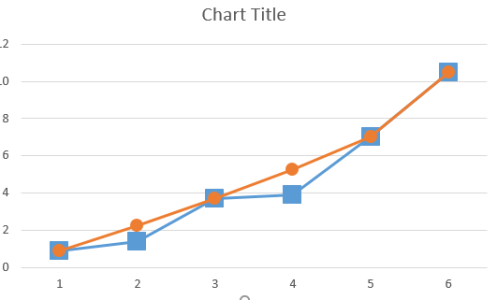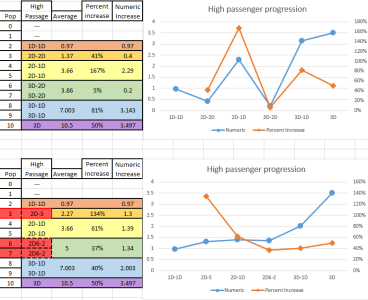I would consider moving the average by +55.5% to be statsistically significant.
This is the approach I would want to take as well.
An additional wrinkle is that for interstellar charters, the revenue per high passenger is Cr9000 (so, 90% of base ticket price) and the revenue per middle passenger is ... Cr0.

(LBB2.81, p9).
The interstellar charter price for low passengers is Cr900 each (90% of base ticket price again) and for cargo is Cr900 per ton (once more, 90% of base ticket price).
The deal with interstellar charters is that they basically "sell out" the transport capacity of the starship to a third party (who then fills the manifest). The actual occupancy rate (passengers/cargo) does not HAVE TO BE 100% ... but it's more profitable for the third party if they do (for somewhat obvious reasons), otherwise you've got the "18 wheeler goes to pick up a gallon of milk" type of load mismatch going on. However, for third parties that are interested in "concealing" what they need moved, chartering a starship and then not using the entire load capacity is one possible way of throwing unwanted pursuit off their tail.
After all, who charters an entire J1 Free Trader to transport 1 ton of specialty cargo and 2 passengers?
Answer ... someone who wants to "avoid any
Imperial entanglements..."

The "traditional" mix is Steward-1/Medic-2+.
Since a passenger service "needs both" to service high passengers, just go ahead and combine the two crew positions into a single crew member (Steward/Medic).
- 2 people (steward, medic) require 2 staterooms (8 tons), have crew salaries of Cr2500 per 2 weeks and life support overhead costs of Cr4000 per 2 weeks.
- So the starship "pays" 8 tons and Cr6500 in overhead operating expenses per (single) jump to support these 2 crew.
- 1 person (steward/medic) requires 1 stateroom (4 tons), has a crew salary of Cr2062.5 per 2 weeks and a life support overhead cost of Cr2000 per 2 weeks.
- So the starship "pays" 4 tons and Cr4062.5 in overhead operating expenses per (single) jump to support this 1 crew.
Do the (economics) math and it becomes really easy to see why 1 person skilled enough to fill 2 crew positions is significantly cheaper on the accounting, but much more vulnerable to battle damage and security compromises (more eggs in fewer baskets problem).
In point of fact, the J2 Far Trader does this in LBB S7, p23-27 and is explicitly detailed on p24 ... so there is certainly precedent for the option of having a steward/medic aboard.
Correct.
High passengers get priority, bumping middle passengers (if any).
As I previously pointed out upthread, if you declare multiple destinations in advance (because you are committing to a plotted route) you can gather up all of the tickets going to multiple destinations (not just the single "next" one) in order to basically roll "multiple times" on the passenger and cargo tables in ways that can keep your manifests 100% full at all times with ticket sales. However, doing so requires commitment, in advance, of going to those destinations and following your plotted course.
This is where having a "regular route" to run that has been plotted in advance is advantageous, relative to the alternative of just turning up and finding out which way the ticket winds are blowing (right now) the way that a tramp would. Following a pre-plotted route makes it possible to take on passengers and cargoes for multiple destinations and "roll over" your transport capacity selectively (rather than entirely) at every destination you stop at.
Kind of like connecting flight stopovers where as a passenger (with luggage) you stay onboard the plane while some people disembark and new people get on and get seated before departing again. Substantially the same idea in Traveller terms ... except that if you're traveling "2 destinations" down the plotted route of a starship, you're buying 2 tickets, not just 1.
This is then what makes multi-jumping through empty hexes practical in economic terms (if you can manage the fuel requirement to do so).
The empty hex is an "intermediate destination" (LBB2.81, p9) but no passengers or cargo depart the starship. All passengers and cargo remain aboard (except for the REALLY unruly ones who need to "take a long walk out a short airlock"


) and have a second ticket for the jump to the "final destination" where they disembark.

So in business model terms, being a tramp merchant is "riskier" since you aren't following a pre-planned course and therefore can't sell tickets to multiple destinations at each starport, making it more difficult to keep your shipping manifest 100% full at all times for every jump. Conversely, tramp merchants are more "agile" than planned/pre-plotted trade route business models can be, because the tramp merchants are "always on the lookout" for speculative goods opportunities (which are random, when they appear, and thus random in "where the best place to go to sell them" for arbitrage markup is likely to be).
If a collection of disparate trade codes are clustered together closely enough, it's easy to set up a regular route that hits all of them on a routine basis, so even pre-plotted routes can take good advantage of speculative goods arbitrage (if the astrogation is favorable). But when those disparate trade codes start getting separated by 3+ parsecs to each one, it gets harder and harder to use a pre-planned route to "hit them all" in a favorable sequence, so at that point tramp traders (with no preset destinations) have an advantage over their competitors running "on rails" through pre-planned routes. Very much a risk vs reward type tradeoff.
And there's nothing which says that a wily operator "can't do both" ... such that they've got what amounts to "2 trading lobes" with an "economic dead zone" in between them. So the merchant operates as a tramp in the 2 "favorable lobes" on either end of their territory range, but switches to a plotted/pre-planning when needing to move through the low population region between the 2 favorable regions. This kind of "shuttling back and forth" would presumably be a good idea if trade codes in one region only match up advantageously with trade codes in the other region (Agricultural in area 1 shipping to Non-agricultural in area 2, for example) when dealing in speculative goods. So only when a speculative goods opportunity turns up that can be best taken advantage of by "crossing the economic dead zone" (to get to the other side) would a tramp be (profit) motivated to do so.

However, those kinds of details only start becoming relevant once you've got a MAP that shows you all of the population brackets (low, non-industrial, mid, high) and trade codes, at a glance, so you can make easy decisions on where to take your merchant starship next to optimize your profit potential.








